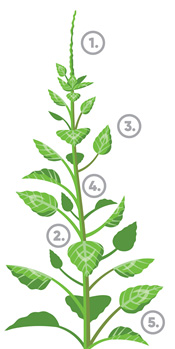Over the last decade, Palmer amaranth has infiltrated the Midwest and made a name for itself as one of the most competitive weeds in corn and soybean fields.
This weed is a serious challenge due to its long germination period and rapid growth — it has even been found to reduce soybean yield by nearly 80% and corn yield by more than 90%.1 The best way to minimize the threat of Palmer amaranth is to quickly identify new infestations and initiate control measures.
Identifying Palmer Amaranth
 Here are the characteristics that can help you identify Palmer amaranth:
Here are the characteristics that can help you identify Palmer amaranth:
- The terminal seed heads on female Palmer amaranth plants can grow up to 3 feet long and will feel prickly.
- The petioles will be as long or longer than the leaf blades themselves.
- The leaves tend to be wider and ovate to diamond-shaped. Leaves may have a sharp spine at their tips.
- The stems are smooth and hairless.
- Some leaves have a white chevron-shaped watermark.
Fast Facts on Palmer Amaranth
- Palmer amaranth can grow up to 2½ inches per day.
- The weed is dioecious, meaning male and female flowers grow on different plants. This trait increases genetic diversity, allowing Palmer amaranth to develop herbicide resistance more easily.
- Female flowers have large bracts (up to ¼ inch long) that can become sharp, making the seed heads painful to handle. One female Palmer amaranth weed can produce more than 600,000 seeds.
- Palmer amaranth seeds are small and thrive in no-till or minimal tillage fields, where they can remain in their ideal emergence zone: the top inch of soil. Humans can easily transport the small seeds through grain, seed or feed contamination; or on harvesting equipment.2
- Unlike for most summer annual weeds, Palmer amaranth has a growing period that extends well into the typical crop season and can even occur after harvest.
- Populations of Palmer amaranth have shown resistance to several herbicide groups, such as Group 2 (ALS inhibitors), Group 9 (EPSP synthase inhibitors) and Group 14 (PPO inhibitors). According to the International Herbicide-resistant Weed Database, populations of herbicide-resistant Palmer amaranth have been reported in 34 states.

Control Tips
Use a herbicide program approach with multiple modes of action and residual activity to control Palmer amaranth. This means including residuals in both the preemergence and postemergence applications. Timely applications (when weeds are small: 4 inches or shorter) are critical in reducing Palmer amaranth populations.
Corteva Agriscience offers several herbicide solutions so you can tailor weed control programs to fit your farm. Learn about top solutions to help fight the toughest weeds found in corn and soybean fields this year.
You can also implement several cultural practices to control Palmer amaranth. Some of these include:
- Rotating crops to allow for different herbicide modes of action to be used.
- Harvesting any fields with heavy infestations last to prevent spread.
- Deep tillage to reduce the amount of weed seeds that germinate by burying them at unfavorable depths.
- Planting in narrow rows to help soybeans, for example, outcompete weeds for sunlight and nutrients.
- Planting fall-seeded cover crops like cereal rye.
Work with your Corteva Agriscience representative to identify which products and practices make the most sense to control Palmer amaranth on your farm.
1Hager, A. 2018. Remain Vigilant for Palmer Amaranth.
https://farmdocdaily.illinois.edu/2018/07/remain-vigilant-for-palmer-amaranth.html
2Legleiter, T., and B. Johnson. 2013. Palmer Amaranth Biology, Identification, and Management.
https://www.extension.purdue.edu/extmedia/ws/ws-51-w.pdf

 Here are the characteristics that can help you identify Palmer amaranth:
Here are the characteristics that can help you identify Palmer amaranth: